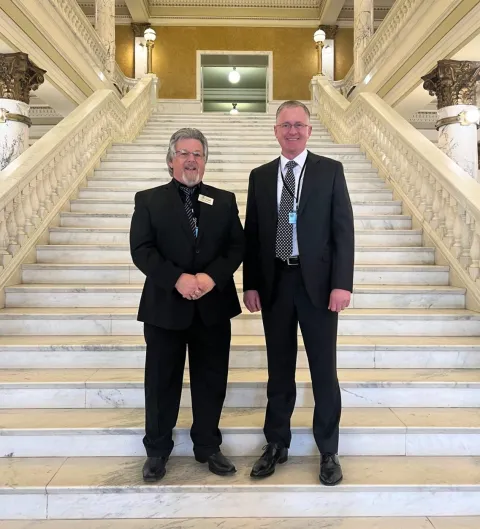South Dakota invests in the future of world-leading science at SURF
The State of South Dakota allocated $13M to expand the underground footprint at SURF with new space for future experiments. On March 23, South Dakota Gov. Kristi Noem signed Senate Bill 35 to allocate $13 million for the expansion of SURF.
On March 23, South Dakota Gov. Kristi Noem signed Senate Bill 35 to allocate $13 million for the expansion of the Sanford Underground Research Facility (SURF), which is managed by the South Dakota Science and Technology Authority (SDSTA). SURF is the deepest underground lab in the United States and hosts world-leading research in physics, biology, geology, and engineering.
The decision comes at a critical time, when the international particle physics community is preparing to finalize priorities and select host sites for future experiments.
“With this investment, the State of South Dakota is stepping up to ensure that SURF remains a world leader,” said Mike Headley, executive director of the SDSTA. Headley noted that the next generation of experiments will begin underground construction as early as 2030. “This strong support from the state positions SURF to remain a competitive, multidisciplinary laboratory.”
For South Dakotans, the investment goes beyond science. Current projects at the facility are projected to generate $2 billion in net economic impacts and 1,200 jobs through 2029. Experiments hosted in the two additional caverns would generate up to $500 million in revenue per cavern.
“The Sanford Underground Research Facility provides great job opportunities for South Dakota’s best and brightest; will provide a $2 billion dollar net economic impact in our state through 2029; and keeps these research projects in the United States instead of competing countries,” said Senate Majority Leader Casey Crabtree. “Today’s investment solidifies our position as a world leader in research and will continue to provide a strong return for South Dakotans for years to come.”
Additionally, SURF's education program reaches more than 20,000 students and 500 educators across the state each year, and members from SD universities are involved in 24 of the 29 ongoing research projects at SURF.
“The SDSTA is very pleased that Gov. Noem has signed Senate Bill 35 to provide the critical infrastructure for expansion at SURF,” said Casey Peterson, chair of the SDSTA Board of Directors. “This will continue our mission of underground science exploration; education for all STEM students; and economic development, providing well-paying jobs and opportunities for South Dakota’s best resource—our credible, smart, and worthy young people.”

Expanding America’s underground science facility
In July 2022, the U.S. particle physics community strongly recommended that new underground space be excavated at SURF to house next-generation experiments. The SDSTA developed a phased plan to expand the SURF underground footprint to host up to six additional major experiments on the 4850 Level.
Phase One, which will develop critical ventilation and rock removal infrastructure to prepare for major excavation, is now funded by South Dakota’s $13 million investment. Thyssen Mining Company (TMI) is currently mobilized at SURF, excavating large caverns for the Long-Baseline Neutrino Facility (LBNF). LBNF will house the Deep Underground Neutrino Experiment (DUNE), the largest particle physics experiment attempted on U.S. soil.
Phase Two will excavate two large caverns. The SDSTA is seeking $100M in private investment for Phase Two.
SURF currently hosts 29 ongoing research projects, and the excavation of LBNF is 60% complete. LBNF/DUNE is hosted by the U.S. Department of Energy’s Fermi National Accelerator Laboratory.
“The successful construction and installation of LBNF/DUNE is essential for SURF’s future and is our highest priority,” Headley said. “Our phased plan for further expansion was designed to ensure that new excavation can happen without interrupting LBNF and DUNE or the robust suite of ongoing experiments at SURF.”
